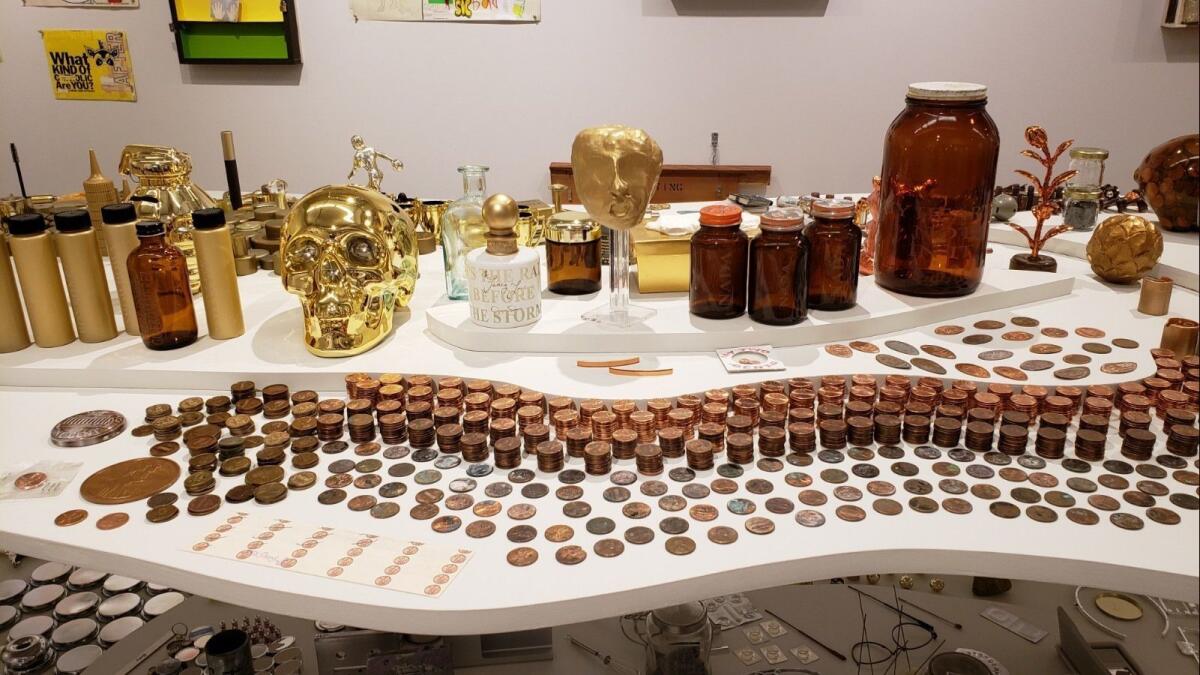Review: Random junk takes on weirdly personal meaning in this UC Riverside Arts show

In the 1950s, a lot of artists began using the discarded castoffs of thriving commercial culture to make sculptures. Assemblage art was born.
The flood of mass-produced material goods that fueled their diverse assemblages continues. But, it has long since been joined by something more evanescent, less corporeal — an information torrent of words and pictures that is today carried along in the roaring digital bit-stream.
Nothing high-tech characterizes the lively installation by Xavier Cázares Cortéz currently at the UC Riverside Culver Center of the Arts. In fact, quite the opposite: Six low, square pedestals and five tall, two-tiered tables are laden with thousands of ordinary things — bottle caps, pencils, broken toys, eyeglass frames, coins, plastic utensils, scissors, rings and much more. A host of domestic flotsam, it’s as if an enormous junk drawer in the kitchen has been ransacked, dumped on the floor and laid out for inspection.
Yet, “Fingers are crossed, just in case,” as the work is titled, doesn’t feel like an old-fashioned assemblage display. Cortéz has sorted the mundane goods by color, organizing the objects on pedestals and tables like crayons from a box — blue one here, yellow there, plus red, hot pink, black, metallic (silver, copper and gold) and so on. In a gallery handout he’s likened the chromatic insouciance to Color Field painting, and indeed the organizational motif swallows any inclination to read the objects as narrative subject matter.


Whereas similarly sifted castoffs by British sculptor Tony Cragg once created 1980s pictograms that evoke scavenger hunts along the beach to trigger personal memory, Cortéz’s are vaguely anthropological. Each ensemble is evidence of what makes us human.
Surrounding walls are papered with simple collages and rudimentary assemblages that, like the tabletop displays, seem to have been composed from material plucked from the swirling maelstrom almost at random. Cortéz has applied standard museum methods of collecting, cataloging and displaying. Every object and fragment becomes something worthy of scrutiny, whether it’s a broken cigarette lighter or a shard of colored glass, depending on your sincere interest or passing whim.
Each object is an idiosyncrasy. It’s just junk, but it’s weirdly personal, intimate. The square floor pedestals lend formality, while the organic shapes of the tiered tables prize unforced artlessness. An organized chaos of senselessness results.
The emblem for this seductive exhibition might be a shark, which indeed turns up repeatedly throughout — a rubber toy here, a banner there, a collage or drawing in between. Many sharks survive by constantly swimming, oxygen-rich water flowing over their gills to allow them to breathe. As a metaphor for survival in navigating a disorienting age of ceaseless digital information that can be bracing and overwhelming all at once, it feels just right.

UC Riverside’s Barbara and Art Culver Center of the Arts, 3834 Main St., Riverside. Through Aug. 19; closed Mondays. (951) 827-4787, www.artsblock.ucr.edu
christopher.knight@latimes.com
Twitter: @KnightLAT
More to Read
The biggest entertainment stories
Get our big stories about Hollywood, film, television, music, arts, culture and more right in your inbox as soon as they publish.
You may occasionally receive promotional content from the Los Angeles Times.











